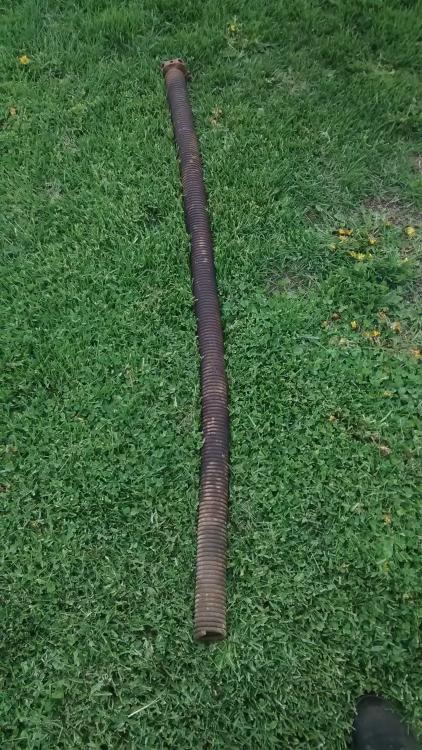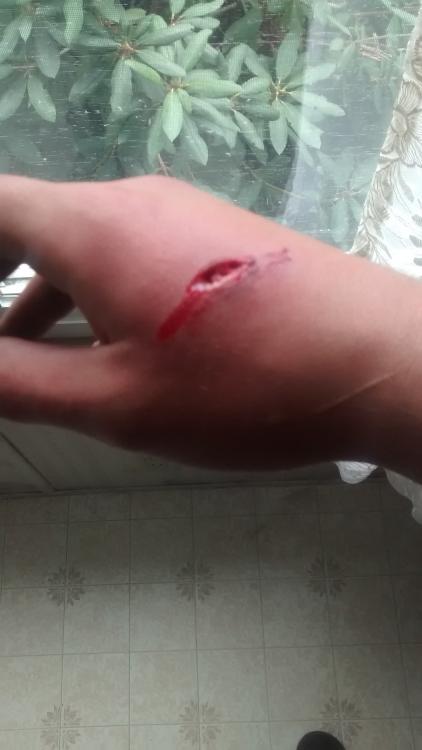-
Posts
733 -
Joined
-
Last visited
Content Type
Profiles
Forums
Articles
Gallery
Downloads
Events
Everything posted by Will W.
-
Very nice! The patterns are captivating.
-
JHCC Now that's a good idea! Thanks for the tip.
-
I like the profile. Dimensions? What kind of steel? What kind of wood?
-
Just saw your post Thomas. Even if I run a magnet over it multiple times to "purify" it? I've read about how if you sand a lot near where you picked the powder up (which I do) the aluminum oxide could get mixed in there. Same with the silicon carbide off of grinding wheels, but I figured a magnet would pick up only the steel and leave that stuff behind.
-
No worries, pigpen, I'm guilty of asking questions without checking the forum myself. But believe me, you check the forums looking for a way to do scrolls, and you come away knowing how to make a pair of tongs, how to dress your hammer faces, how to vein a leaf, how to make chain, etc. etc. I've done some work on a chunk of rail myself, and I think they work great honestly. It doesn't have to be shaped like an anvil to work like an anvil. A fellow member, Daswulf, had a thread about using a big piece of granite as an anvil! I only offer the advice about learning the basics first, because I was one of those people when I started who bit off WAY more than I could chew. I read everywhere "learn the basics first" but I thought... how hard can it really be?... I have a pile of my first attempts to make spears, axes, knives etc. And those were some of the first things I tried to forge! Not beginner projects. My point is, I wasted a lot of time, fuel, and material because I didn't listen, and learned that lesson the hard way. My little piece of wisdom? Don't do that. Good luck.
-
Will do. When I get around to it... Seriously! The creativity here is amazing! Awesome idea!
-
Heating a single area would be easier in a solid fuel forge than a propane forge. Obviously irrelevant if you have a gas forge, so I digress. You could heat your piece up and dunk whatever you don't need hot in water (so long as it is NOT hardenable steel) this comes in handy for upsetting a specific section. Learning to manipulate the metal and move it where you want takes time and experience. I recommend you take some mild steel and just play with it. Take a square piece and make it round. Then make it square. Then make it round. Make some tapers on both the ends of those square and round rods. Take and bend those tapers around and make some S hooks. You may not want to be a professional hook maker, but exercises like this teach you to predict how the metal will move and work proactively instead of reactively. It is my personal opinion that if you do not know how to move metal, you shouldn't be trying to make tomahawks, you should be learning to move metal. Do you know any carpenters who have no idea how to read a measuring tape, but want to build a house? I'm not trying to be a harsh, it's just the way it is. Another piece of advice: READ THE FORUM!!! Questions like yours are all over the place, and answers like mine are as well. Whatever questions you have may have already been answered, and you may learn things that you didnt know you needed to know. There is so much knowledge and wisdom here that many members have literally spent lifetimes collecting, and offer to you freely. It's worth your time, and then some. My rant is now over. Good luck.
-
Yeah!!! I hope you don't mind if I... Ugh... "Borrow" that idea haha.
-
Garage door spring is truly wondrous material apparently! The possibilities are endless.
-
What I did for the dirt floor in my smithy: weld a 4' steel pipe to a 2'x2' 1/4" steel plate (metric: 120 cm long pipe, 60x60 cm plate, 6 mm thick). Wet the dirt with a garden hose and pack it down with your newly built tamper. If you have no access to a welder, I've seen it done with a sheet of plywood and a few people walking all over it. Either way, it packs the dirt really well and makes it feel quite hard. Over time it will loosen (from you shuffling your feet, dropping things, etc.) This can be combatted by sprinkling quick setting concrete on top of the wet dirt before tamping, or just re tamping it every once in a while. Hope that helps!
-
Well done, JHCC. That is very nice. How about some dragonscale weave next? Full Persian, perhaps?
-
My vote goes for an entire hauberk! Or a coif, at least!
-
Nice! That looks awesome! You beat me to the punch haha.
-
This is why I've been collecting my scale (and grinding powder) for quite a while. I have a few pounds of it saved up and I would really like to smelt it back together... Some day...
-
I'll post some pics once I get around too it. Should be the heaviest hauberk this side of anywhere.
-
JHCC I have a lot of plans for all that steel. Giant chainmail (just for fun), round chain, punches, small drifts, small chisels, center punches, flatten some for damascus (eventually) and now nails are on that list too!
-
Full garage door spring. 3/8" material diameter. 2 inch ID. 2xπ= 6.28" per coil. 185 coils. 6.28x185= 1162" (rounded up.) 1162/12= ~97 feet. I also have a smaller one with 115 coils, same ID and stock diameter. Another 60 feet. Collectively almost 160 feet of 3/8" spring steel. And this was just from one garage door being changed.
-
Glad to hear it, Frosty.
-
Frosty Had to do a little digging but I found it. I'm sorry to hear about that, but definitely glad you're OK now. Jackdawg If the makita doesn't clamp down on them too well, I would be careful using it for even wire wheel duty.
-
Nothing gets by you guys haha. No, admittedly, there was no guard. Ding! Another foul. I was pretty much asking for disaster, I realize that, but I was in too much of a rush. Frosty I was making a few cuts on the stock to save from having to grind it out, hacksaw probably would have worked, but again, too much of a rush. Did it require that dangerous tool with a lethally incorrect wheel on it? Nope. Definitely not. I hope youre not kidding about if I want to know why you're called Lucky. That sounds like an interesting story. Thanks for the wisdom and kind words as well. Anachronist Thank you. Das Thank you. I don't plan on doing that again. Like frosty said, a few millimeters could have meant me losing 1. A lot of blood, or 2. Mobility in a finger or two. On my dominant hand nontheless! I'm glad to hear you took the wheel off that deathtrap though.
-
Any blade you make will still have a "soul" to it. The steel was still wrought by your hand, the design created by your mind, and the beauty shaped by your persistance. The amount of blood and sweat that goes into it is strictly up to you.
-
Woops, thanks for moving that for me Glenn. I appreciate the wisdom, as I'm sure others will too. It was one of those go, go, go moments where safety was forsaken in favor of production. "The customer has been waiting long enough" I kept thinking. Would have taken me about 45 minutes to run and get another wheel, now I'll be lucky if I'm only a day or two behind. And yeah, the mobility is still there. The gauze and medical tape are somewhat restrictive, however haha. Thank you for the kind words as well.
-
Was in a hurry to get a knife done for a customer, just got the steel this morning. Was making a few cuts with my 4-1/2" angle grinder and the cut off wheel wore out. Looked around, couldn't find another *proper* one. But I did find about a 7 inch cut off wheel (probably for a demo saw) stupid me, I thought "I only have one more cut to go, what's the big deal?" Threw it on the grinder, about 5 seconds into cutting, it exploded, and a piece nailed me in the hand (wasn't wearing gloves.) It cut to the bone. I'm just glad it didn't hit me in the face, or the neck. Im all patched up now, though typing one handed. Todays lesson in the School of Hard Knocks: Don't use improper grinding wheels, even if it is just one little cut you have to make. P.S. That scar on my wrist that's kind of hard to see? Also from a grinder. One would think the lesson would have been learned the first time.
-
It sounds like you are referring to a bloomery, the type of furnace used to smelt iron. I've read about traditional Japanese techniques where they take iron sand and smelt it into a semi solid chunk of mid/low carbon steel. The iron collects carbon from the charcoal being burnt. The bloom (semi solid chunk) is porous and impure, which necessitated the repeated welding, cutting, folding, rinse and repeat, in order to make it more homogenous, and to work out the slag and porosity. It is definitely a lot of work, but I agree, I would like to do it myself as well.
-
This. I use Nicholson files all the time, I buy them at a local hardware store, and they have lasted me a long time. You just have to make sure you get the good ones.



